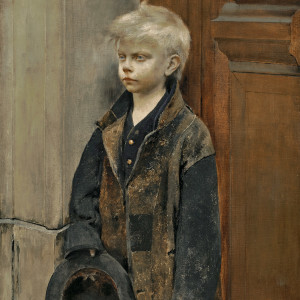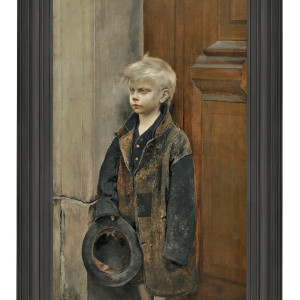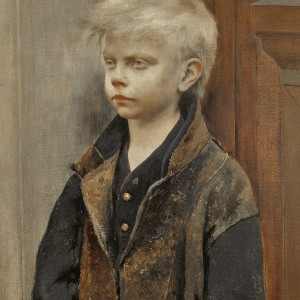156.2 by 78.7 cm.
Monsieur Pelez was the painter of the impoverished. He knew the suburbs and the working-class outskirts; he knew the suffering of the homeless and the destitute. He understood the agony of those forced to live without homes and without bread. All of his subjects were taken from everyday life and uncovered a corner of contemporary reality.”
— François Hoffman
Provenance
Possibly collection of Prince StirbeySale: 1969
Private collection
Sale: Sotheby’s, June 21, 2012, lot 155
Private collection, California (acquired at the above sale)
Exhibited
Paris, Salon des artistes français, 1886Paris, Exposition rétrospective des œuvres de Fernand Pelez, 1913, no. 9
Literature
Fernand Pelez, La parade des humbles, 1848-1913, exh. cat., Petit Palais, Paris, 2009-2010, p. 184, ill. 4 (illustrated)Catalogue note
In December 1913, just a few months after Fernand Pelez’s death, an exhibition of his most important works was held in his studio at the foot of Montmartre in Paris. A reproduction of this painting depicting a young street urchin wearing a grown-man’s threadbare jacket and holding an equally oversized bourgeois top hat, his delicate skin tones overlaid with a veil of dirt,adorned the cover of the catalogue. It was accompanied by a single word: “misère.”
While this term in French usually translates as simply physical poverty, in the nineteenth-century “misère,” as Linda Nochlin has shown, connoted a condition of “poverty felt morally" and bearing upon all humanity. First shown at the Salon of 1886, this painting entitled Petit Misère, combines meticulous detail with emotional distance so as to elicit a broadly sympathetic view of the conditions of the industrial underclass. Rather than depicting a narrative scene, misery is here conveyed through the young boy’s physical appearance, his scavenged and tattered clothing, and physical proximity to the viewer in the shallow space of the picture. Lacking the idealization of the history painting or religious martyr scenes upon which he was trained, Pelez painted this figure naturalistically and almost as if “there is mud in his brush,” as the critic Émile Henriot described it. The young boy stands in the doorway of Pelez’s studio at 62 Boulevard de Clichy, appearing as though the artist had just encountered this familiar figure on the street. Yet his vacant stare combined with the thin, flat application of paint in a retrained, neutral palette suggests that perhaps this figure represents one of Paris’ most recognizable types—the gamin, or the street urchin—rather than a distinct individual. A favorite trope in visual and literary discourse of the later nineteenth century, the gamin was so thoroughly embedded in the legibility of the modern city that Victor Hugo proclaimed in the 1862 novel, Les Misérables, that “[T]he gamin stands for Paris.”
Pelez’s fascination with naturalistically depicting the pathos and vulnerability of the urban lower classes distinguishes him from his more well-remembered contemporaries such as Jules Bastien-Lepage whose naturalistically depicted the laboring classes in rural, rather than urban, milieus. Some scholars have compared Pelez’s works to contemporaneous images of the urban lower classes by Georges Seurat, Edgar Degas, and Henri Toulouse-Lautrec, however their stylistic concerns differ considerably. Known widely in his day, this artist working on the fringes of the Parisian avant-garde occupies an incomparable position as thechronicler of the Belle Époque’s other side—its marginalized, its destitute, its down-and-out, and its forgotten. It is for this reason that recent interest has been revived and collected around the spectacular paintings of Fernand Pelez who, in 1901, described each of his works such as Petit Misère as individual pages in the book describing Paris’ misérables.






